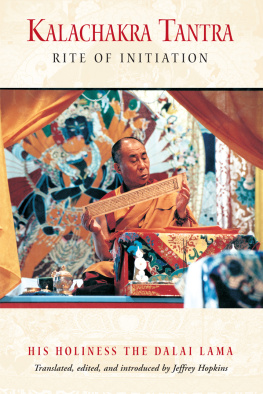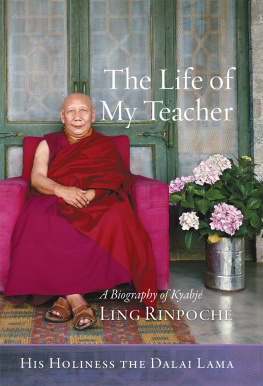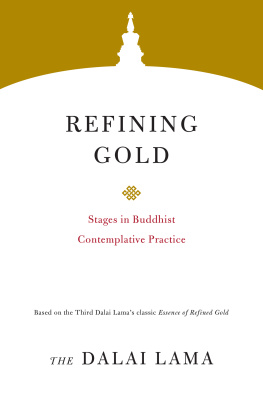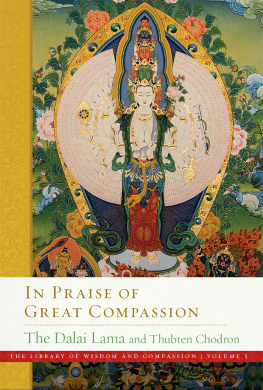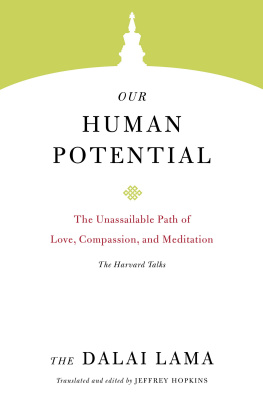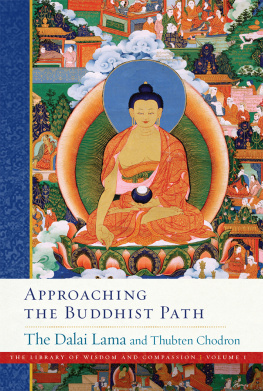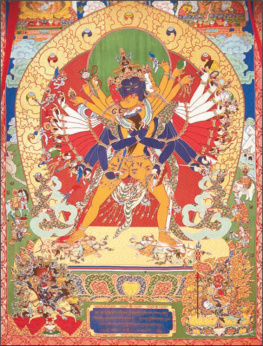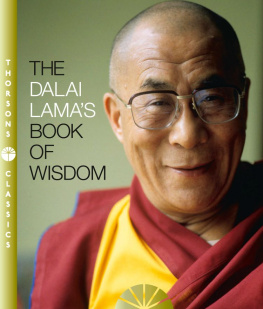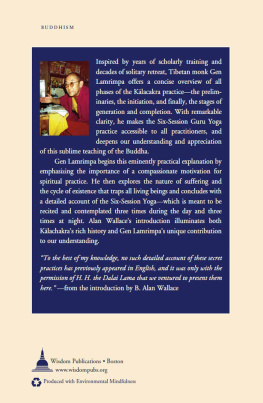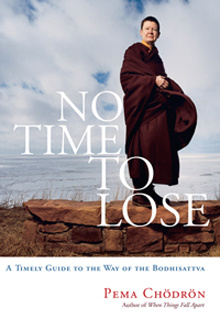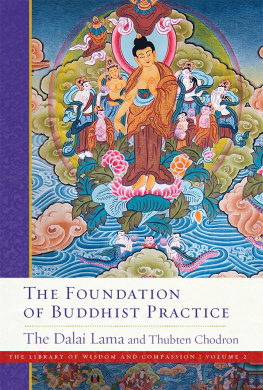

A SSOCIATED WITH THE PROMOTION OF WORLD PEACE, the Kalachakraor Wheel of Timetantra is one of the most detailed and encompassing systems of theory and practice within Tibetan Buddhism. This book contains a complete translation of the Kalachakra initiation ritual with commentary from His Holiness the Dalai Lama, and a comprehensive introduction by Professor Jeffrey Hopkins that explores the Kalachakras rich symbolism, meaning and history. The book also includes the Six-Session Yoga daily practice rite.

HIS HOLINESS THE DALAI LAMA is the spiritual and temporal leader of the Tibetan people. A winner of the Nobel Peace Prize, he has dedicated his life to teaching compassion and understanding. He lives in Dharamsala, India.
JEFFREY HOPKINS is a professor of religious studies at the University of Virginia. He has served as the Dalai Lamas chief interpreter and is the author of over twenty books on Tibetan Buddhism.
Contents
This book is concerned with a rite of initiation for the Klachakra (Wheel of Time) Tantra, a Buddhist tantra of the Highest Yoga Tantra class. It presents the series of initiations authorizing practice of the first of two stages involved in the tantra, the stage of generation the period of imaginative appearance as an ideal being. A system of daily practice required of those who have received initiation is also included. Discussed are the process of preparing the student for initiation and the actual stages of the seven initiations that authorize practice of visualization of a practitioner as a deity or ideal, altruistically active being in a mandala, an ideal environment.
This is the first time that a tantric initiation ritual has been explained in detail in a Western language. The initiation ritual is translated, interspersed with commentary from His Holiness the Dalai Lama, temporal and spiritual leader of Tibet, mainly from a ceremony conducted in Wisconsin in 1981. The Klachakra initiation was offered for the first time in the West by His Holiness the Dalai Lama during July of 1981 (the year of the Iron Bird) at Deer Park, a small rural site outside of Madison, Wisconsin, that is the home of a Tibetan Buddhist monastery and temple. The initiation was organized and sponsored by the Deer Park Buddhist Center and friends, a Buddhist organization under the direction of the Venerable Geshe Sopa, author of Steps on the Path to Enlightenment.
During the process of the initiation, the Dalai Lama, as is customary, gave copious commentary detailing the proper attitude and motivation of the recipient and the individual steps of visualization and of reflection on profound and subtle topics that are at the heart of the initiation, or authorization, process. His explanations offered during the ceremony, as well as others given privately to me in preparation for serving as his translator, bring the basic initiation ceremony to life, rich with meaning and contextualization. The special tantric techniques for transforming body, speech, and mind into completely altruistic expression are thereby made lucid and accessible to interested readers.
The introduction first describes the general Great Vehicle view on purification into a state of altruistic service as well as the special tantric practice of deity yoga that is founded on compassion and realization of emptiness. Next, it describes the process of initiation for the stage of generation, outlining and explaining the many steps in the ritual. It also provides background on the history of the Klachakra Tantra and introduces the authors and texts.
I would like to thank Elizabeth Napper for making numerous editorial suggestions on the entire manuscript, Gareth Sparham for typing the translation of the ritual text, and Karen Saginor and Daniel Cozort for proof-reading the galleys. As is detailed in the ninth chapter of the introduction, I have attempted, through consulting lamas competent in the tradition, to keep errors of translation and interpretation to a minimum; I ask for readers forebearance for those undiscovered.
Jeffrey Hopkins
Charlottesville, Virginia
The names of Tibetan authors, orders, and places are given in essay phonetics for the sake of easy pronunciation; for a discussion of the system used, see the Technical Note at the beginning of my Meditation on Emptiness, pp.19-22.
Transliteration of Tibetan in parentheses and in the glossary is done in accordance with a system devised by Turrell Wylie; see A Standard System of Tibetan Transcription, Harvard Journal of Asiatic Studies, Vol. 22, 1959, pp.261-7. For Sanskrit citations, ch, sh, and h are used instead of the more usual c, , and for the sake of easy pronunciation by non-specialists; chh is used for ch.
Publishers Acknowledgment
The Publisher gratefully acknowledges the generous help of the Hershey Family Foundation in sponsoring the printing of this book.
Introduction
by Jeffrey Hopkins
In Buddhism, liberation is always from a state that needs healing and to a healed state of release and greater effectiveness. Buddha is viewed as like a physician; practitioners are like patients taking the medicine of Buddhas doctrine in order to be cured from a basic illness and to achieve a state of health necessary for widely effective altruistic endeavor.
According to explanations standard in Tibetan Buddhism, and Stra School in which the mental and physical continuum of an enlightened being is said to be completely severed at the time of death, there is a period, subsequent to enlightenment, of far more effective interaction with others, as was the case with Shkyamuni Buddha. According to the Great Vehicle schools of tenets the Mind Only School and the Middle Way School which hold that the continuum of mind never ends, the primary aim of Bodhisattvas is to bring about the welfare of other sentient beings and the means to accomplish this is their own enlightenment, the gaining of authentic freedom. For, with the attainment of a Buddhas enlightenment, there is gained a limitless, unending, spontaneous capacity to help others effectively.
What distinguishes someone as a Bodhisattva is to engender an altruistic intention to become enlightened, which, through training, has become so spontaneous that it is as strong outside
Mind generation is asserted as a wish for complete Perfect enlightenment for the sake of others.
This has been formulated into a definition of bodhichitta or, as I translate it, altruistic intention to become enlightened:
a main mental consciousness induced by an aspiration for [bringing about] others welfare and accompanied by an aspiration to ones enlightenment.
It is an attitude endowed with two aspirations, the first for others welfare and the second for ones own highest enlightenment as a Buddha, the latter being seen as a means for accomplishing the first. Even though ones own enlightenment must be accomplished first in order to bring about others welfare, service to others is prime in terms of motivation.
The enlightenment of a Buddha is seen as a means to bring about others welfare because a Buddha, being omniscient, knows all possible techniques for advancement and knows in detail the predispositions and interests of other beings. Between the two bodies of a Buddha, Truth Body and Form Body (the latter including the Complete Enjoyment Body and the Emanation Body), Bodhisattvas primarily seek Form Bodies, since it is through physical form that the welfare of others can be accomplished, this being mainly through teaching what is to be adopted in practice and what is to be discarded in behavior. Though Truth and Form Bodies necessarily accompany each other and thus are achieved together, the Bodhisattvas emphasis is on achieving Form Bodies in order to appear in myriad forms suitable to the interests and dispositions of trainees and to teach them accordingly.
Next page
